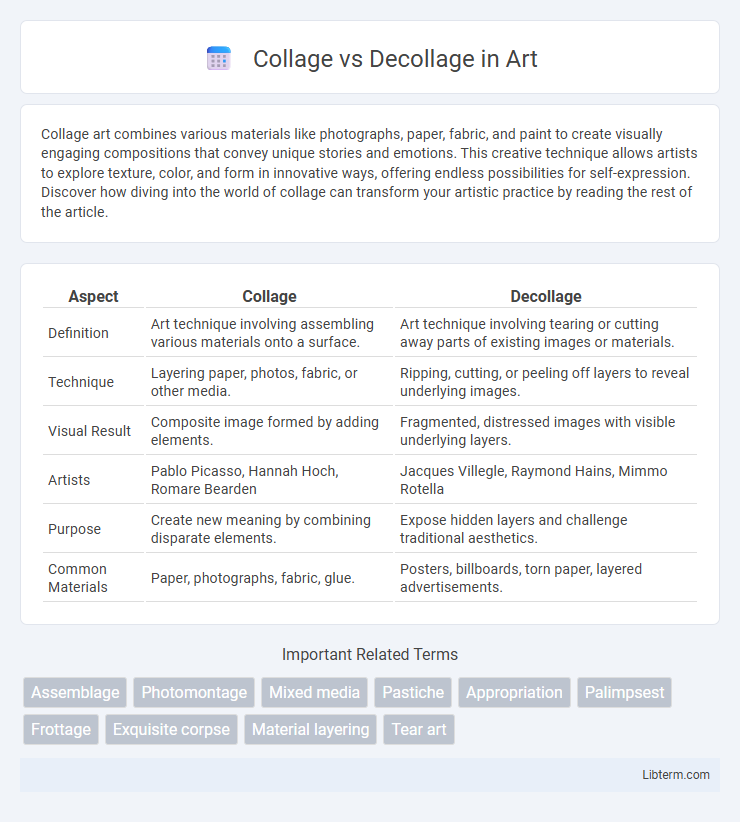Collage art combines various materials like photographs, paper, fabric, and paint to create visually engaging compositions that convey unique stories and emotions. This creative technique allows artists to explore texture, color, and form in innovative ways, offering endless possibilities for self-expression. Discover how diving into the world of collage can transform your artistic practice by reading the rest of the article.
Table of Comparison
| Aspect | Collage | Decollage |
|---|---|---|
| Definition | Art technique involving assembling various materials onto a surface. | Art technique involving tearing or cutting away parts of existing images or materials. |
| Technique | Layering paper, photos, fabric, or other media. | Ripping, cutting, or peeling off layers to reveal underlying images. |
| Visual Result | Composite image formed by adding elements. | Fragmented, distressed images with visible underlying layers. |
| Artists | Pablo Picasso, Hannah Hoch, Romare Bearden | Jacques Villegle, Raymond Hains, Mimmo Rotella |
| Purpose | Create new meaning by combining disparate elements. | Expose hidden layers and challenge traditional aesthetics. |
| Common Materials | Paper, photographs, fabric, glue. | Posters, billboards, torn paper, layered advertisements. |
Understanding Collage: Definition and Origins
Collage is an art technique that involves assembling various materials such as paper, photographs, and fabric onto a surface to create a new, unified composition. Originating in the early 20th century, collage was popularized by artists like Pablo Picasso and Georges Braque during the Cubist movement, who sought to break traditional artistic boundaries by incorporating everyday objects into their works. Understanding collage requires recognizing its experimental nature and its role in challenging conventional art by blending disparate elements into a cohesive whole.
Decollage Explained: Meaning and Artistic Roots
Decollage, originating from the French word meaning "to unstick" or "to take off," is an artistic technique that involves tearing away or removing layers from posters or other materials to create a new image, contrasting the additive process of collage. This method gained prominence in the mid-20th century through artists like Mimmo Rotella and Raymond Hains, who used urban posters and advertisements to reveal hidden visual narratives beneath the surface. Decollage challenges traditional composition by focusing on destruction and revelation, making it a powerful expression of post-war culture and modern art movements.
Key Techniques in Collage Art
Collage art utilizes techniques such as layering, cutting, and assembling diverse materials like paper, fabric, and photographs to create a unified composition. Artists often employ methods like tearing, overlapping, and juxtaposition to generate texture and depth, enhancing visual interest. Precise adhesion and strategic placement of elements define the structural and thematic coherence in collage artworks.
Decollage Methods: How Artists Create
Decollage methods involve artists tearing, cutting, or removing layers from posters, advertisements, or printed materials to reveal hidden images and textures underneath, producing dynamic visual effects. Techniques such as ripping, scratching, or peeling away paper surfaces emphasize decay and transformation, contrasting with collage's additive process. Prominent in movements like Nouveau Realisme, decollage challenges traditional art by using destruction and removal as creative tools to engage viewers with fragmented urban realities.
Major Figures: Collage Artists Through History
Collage, popularized by pioneers like Pablo Picasso and Georges Braque in the early 20th century, involves assembling diverse materials to create a unified artwork, contrasting with decollage artists such as Mimmo Rotella who emphasize tearing away layers to reveal fragmented visuals. Major figures in collage also include Hannah Hoch, a Dadaist known for photomontages challenging social norms, and Romare Bearden, who captured African-American culture through mixed media. This technique's evolution reflects shifts in artistic expression, incorporating elements from Cubism, Dada, Surrealism, and contemporary practices.
Spotlight on Decollage Innovators
Decollage innovators redefine art by dismantling layers of posters and images to reveal new compositions, emphasizing texture and urban narratives. Unlike collage, which assembles fragments to create a new whole, decollage extracts meaning through subtraction and exposure of underlying layers. Artists like Mimmo Rotella and Raymond Hains pioneered this technique, transforming discarded materials into powerful cultural commentaries.
Visual Impact: Comparing Aesthetic Outcomes
Collage creates visual impact by layering diverse materials to form a cohesive composition that balances texture, color, and narrative elements, resulting in a multi-dimensional aesthetic. Decollage achieves striking visual outcomes through the removal or destruction of existing imagery, highlighting contrast and raw textures that evoke fragmentation and spontaneity. The aesthetic difference lies in collage's constructive integration versus decollage's deconstructive exposure, each producing distinct emotional and sensory responses.
Cultural and Social Contexts of Each Art Form
Collage emerged during early 20th-century modernism as a revolutionary technique reflecting fragmented realities and urban experiences, often linked to Dada and Cubism movements that challenged traditional art forms. Decollage, popularized in post-war Europe by Nouveau Realisme artists like Raymond Hains and Mimmo Rotella, involved tearing away posters to reveal hidden layers, symbolizing consumer culture's transient and layered nature. Both art forms critique mass media and societal norms but through contrasting methods: collage assembles disparate elements to create new meanings, while decollage exposes destruction and decay inherent in urban environments.
Contemporary Trends in Collage and Decollage
Contemporary trends in collage emphasize mixed media integration, digital manipulation, and the use of found objects to challenge traditional narratives and create layered, textured compositions. Decollage, on the other hand, gains prominence through urban art scenes, where artists peel, tear, and fragment posters or advertising billboards to disrupt visual monotony and evoke socio-political commentary. Both techniques explore deconstruction and reconstruction, reflecting modern cultural fragmentation and the dynamic evolution of visual storytelling in contemporary art.
Choosing Your Style: Collage vs Decollage for Creators
Choosing between collage and decollage depends on your artistic vision and technique preference; collage involves assembling different materials to create a unified image, emphasizing construction and layering. Decollage focuses on deconstructing and tearing away elements to reveal underlying layers, offering a more spontaneous and textured aesthetic. Both styles allow creators to explore themes of fragmentation and juxtaposition but differ in approach, with collage building up and decollage breaking down the visual narrative.
Collage Infographic

 libterm.com
libterm.com